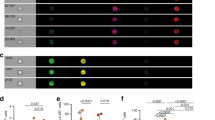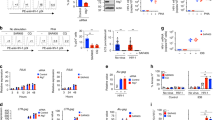Abstract
Many HIV-1–infected patients treated with protease inhibitors (PI) develop PI-resistant HIV-1 variants and rebounds in viremia, but their CD4+ T-cell counts often do not fall. We hypothesized that in these patients, T-cell counts remain elevated because PI-resistant virus spares intrathymic T-cell production. To test this, we studied recombinant HIV-1 clones containing wild-type or PI-resistant protease domains, as well as uncloned isolates from patients, in activated peripheral blood mononuclear cells, human thymic organ cultures and human thymus implants in SCID-hu Thy/Liv mice. In most cases, wild-type and PI-resistant HIV-1 isolates replicated to similar degrees in peripheral blood mononuclear cells. However, the replication of PI-resistant but not wild-type HIV-1 isolates was highly impaired in thymocytes. In addition, patients who had PI-resistant HIV-1 had abundant thymus tissue as assessed by computed tomography. We propose that the inability of PI-resistant HIV-1 to replicate efficiently in thymus contributes to the preservation of CD4+ T-cell counts in patients showing virologic rebound on PI therapy.
This is a preview of subscription content, access via your institution
Access options
Subscribe to this journal
Receive 12 print issues and online access
$209.00 per year
only $17.42 per issue
Buy this article
- Purchase on Springer Link
- Instant access to full article PDF
Prices may be subject to local taxes which are calculated during checkout





Similar content being viewed by others
References
Gulick, R.M. et al. Treatment with indinavir, zidovudine, and lamivudine in adults with human immunodeficiency virus infection and prior antiretroviral therapy. N. Engl. J. Med. 337, 734–739 (1997).
Gulick, R.M. et al. Simultaneous vs sequential initiation of therapy with indinavir, zidovudine, and lamivudine for HIV–1 infection: 100-week follow-up. JAMA 280, 35–41 (1998).
Hammer, S.M. et al. A controlled trial of two nucleoside analogues plus indinavir in persons with human immunodeficiency virus infection and CD4 cell counts of 200 per cubic millimeter or less. AIDS Clinical Trials Group 320 Study Team. N. Engl. J. Med. 337, 725–733 (1997).
Li, T.S. et al. Long-lasting recovery in CD4 T-cell function and viral-load reduction after highly active antiretroviral therapy in advanced HIV-1 disease. Lancet 351, 1682–1686 (1998).
Ledergerber, B. et al. Clinical progression and virological failure on highly active antiretroviral therapy in HIV-1 patients: a prospective cohort study. Swiss HIV Cohort Study. Lancet 353, 863–868 (1999).
Palella, F.J. Jr . et al. Declining morbidity and mortality among patients with advanced human immunodeficiency virus infection. HIV Outpatient Study Investigators. N. Engl. J. Med. 338, 853–860 (1998).
Autran, B. et al. Positive effects of combined antiretroviral therapy on CD4+ T cell homeostasis and function in advanced HIV disease. Science 277, 112–116 (1997).
Condra, J.H. et al. Genetic correlates of in vivo viral resistance to indinavir, a human immunodeficiency virus type 1 protease inhibitor. J. Virol. 70, 8270–8276 (1996).
Emini, E.A., Schleif, W.A., Deutsch, P. & Condra, J.H. In vivo selection of HIV-1 variants with reduced susceptibility to the protease inhibitor L-735,524 and related compounds. Adv. Exp. Med. Biol. 394, 327–331 (1996).
Molla, A. et al. Ordered accumulation of mutations in HIV protease confers resistance to ritonavir. Nature Med. 2, 760–766 (1996).
Condra, J.H. et al. In vivo emergence of HIV-1 variants resistant to multiple protease inhibitors. Nature 374, 569–571 (1995).
Mezzaroma, I. et al. Long-term evaluation of T-cell subsets and T-cell function after HAART in advanced stage HIV-1 disease. AIDS 13, 1187–1193 (1999).
Kaufmann, D., Pantaleo, G., Sudre, P. & Telenti, A. CD4-cell count in HIV-1–infected individuals remaining viraemic with highly active antiretroviral therapy (HAART). Swiss HIV Cohort Study. Lancet 351, 723–724 (1998).
Renaud, M. et al. Determinants of paradoxical CD4 cell reconstitution after protease inhibitor-containing antiretroviral regimen. AIDS 13, 669–676 (1999).
Deeks, S.G., Barbour, J.D., Martin, J.N., Swanson, M.S. & Grant, R.M. Sustained CD4+ T cell response after virologic failure of protease inhibitor-based regimens in patients with human immunodeficiency virus infection. J. Infect. Dis. 181, 946–953 (2000).
Hirsch, M. et al. A randomized, controlled trial of indinavir, zidovudine, and lamivudine in adults with advanced human immunodeficiency virus type 1 infection and prior antiretroviral therapy. J. Infect. Dis. 180, 659–665 (1999).
Borman, A.M., Paulous, S. & Clavel, F. Resistance of human immunodeficiency virus type 1 to protease inhibitors: selection of resistance mutations in the presence and absence of the drug. J. Gen. Virol. 77, 419–426 (1996).
Gulnik, S.V. et al. Kinetic characterization and cross-resistance patterns of HIV-1 protease mutants selected under drug pressure. Biochemistry 34, 9282–9287 (1995).
Rose, R.E. et al. Human immunodeficiency virus type 1 viral background plays a major role in development of resistance to protease inhibitors. Proc. Natl. Acad. Sci. USA 93, 1648–1653 (1996).
Croteau, G. et al. Impaired fitness of human immunodeficiency virus type 1 variants with high-level resistance to protease inhibitors. J. Virol. 71, 1089–1096 (1997).
Zennou, V., Mammano, F., Paulous, S., Mathez, D. & Clavel, F. Loss of viral fitness associated with multiple Gag and Gag-Pol processing defects in human immunodeficiency virus type 1 variants selected for resistance to protease inhibitors in vivo. J. Virol. 72, 3300–3306 (1998).
Zhang, Y.M. et al. Drug resistance during indinavir therapy is caused by mutations in the protease gene and in its Gag substrate cleavage sites. J. Virol. 71, 6662–6670 (1997).
Martinez-Picado, J., Savara, A.V., Sutton, L. & D'Aquila, R.T. Replicative fitness of protease inhibitor-resistant mutants of human immunodeficiency virus type 1. J. Virol. 73, 3744–3752 (1999).
Mammano, F., Petit, C. & Clavel, F. Resistance-associated loss of viral fitness in human immunodeficiency virus type 1: phenotypic analysis of protease and gag coevolution in protease inhibitor-treated patients. J. Virol. 72, 7632–7637 (1998).
Penn, M.L. et al. Primary and recombinant HIV-1 strains resistant to protease inhibitors are pathogenic in mature human lymphoid tissues. AIDS Res. Hum. Retroviruses (in the press).
Rabin, L. et al. Use of standardized SCID-hu Thy/Liv mouse model for preclinical efficacy testing of anti-human immunodeficiency virus type 1 compounds. Antimicrob. Agents Chemother. 40, 755–762 (1996).
Deeks, S.G. et al. Virologic and immunologic consequences of discontinuing combination antiretroviral-drug therapy in HIV-infected patients with detectable viremia. N. Engl. J. Med. 344, 472–480 (2001).
Liegler, T.J. et al. Protease inhibitor-resistant HIV-1 from patients with preserved CD4 counts is cytopathic in activated CD4 T lymphocytes. AIDS 15, 179–184 (2001).
McCune, J.M. et al. High prevalence of thymic tissue in adults with human immunodeficiency virus-1 infection. J. Clin. Invest. 101, 2301–2308 (1998).
Mellors, J.W. et al. Plasma viral load and CD4+ lymphocytes as prognostic markers of HIV-1 infection. Ann. Intern. Med. 126, 946–954 (1997).
Lecossier, D., Bouchonnet, F., Schneider, P., Clavel, F. & Hance, A.J. Discordant increases in CD4+ T cells in human immunodeficiency virus-infected patients experiencing virologic treatment failure: role of changes in thymic output and T cell death. J. Infect. Dis. 183, 1009–1016 (2001).
Rey-Cuille, M.A. et al. Simian immunodeficiency virus replicates to high levels in sooty mangabeys without inducing disease. J. Virol. 72, 3872–3886 (1998).
Hatzakis, A. et al. Effect of recent thymic emigrants on progression of HIV-1 disease. Lancet 355, 599–604 (2000).
McCune, J.M. et al. Factors influencing T-cell turnover in HIV-1-seropositive patients. J. Clin. Invest. 105, R1–8 (2000).
Smith, K.Y. et al. Thymic size and lymphocyte restoration in patients with human immunodeficiency virus infection after 48 weeks of zidovudine, lamivudine, and ritonavir therapy. J. Infect. Dis. 181, 141–147 (2000).
Douek, D.C. et al. Changes in thymic function with age and during the treatment of HIV infection. Nature 396, 690–695 (1998).
Zhang, L. et al. Measuring recent thymic emigrants in blood of normal and HIV-1-infected individuals before and after effective therapy. J. Exp. Med. 190, 725–732 (1999).
Namikawa, R., Weilbaecher, K.N., Kaneshima, H., Yee, E.J. & McCune, J.M. Long-term human hematopoiesis in the SCID-hu mouse. J. Exp. Med. 172, 1055–1063 (1990).
Stoddart, C.A. The SCID-hu Thy/Liv mouse: an animal model for HIV-1 infection. in Handbook of animal models of infection (eds. Zak, O. & Sande, M.A.) 1069–1076 (Academic, London, UK, 1999).
Stoddart, C.A. et al. Antiviral activity of 2′-deoxy-3′oxa-4′-thiocytidine (BCH-10652) against lamivudine-resistant human immunodeficiency virus type 1 in SCID-hu Thy/Liv mice. Antimicrob. Agents Chemother. 44, 783–786 (2000).
Winters, M.A., Schapiro, J.M., Lawrence, J. & Merigan, T.C. Human immunodeficiency virus type 1 protease genotypes and in vitro protease inhibitor susceptibilities of isolates from individuals who were switched to other protease inhibitors after long-term saquinavir treatment. J. Virol. 72, 5303–5306 (1998).
Acknowledgements
We thank M.B. Moreno, C. Bare, J. Bare, K.H. Lee and D. Schmidt for expert assistance; the individuals who participated in this study, Survive AIDS, Project Inform, and other members of the San Francisco AIDS community for support; and the San Francisco General Hospital Department of Radiology for assistance with the CT scans. This work was supported by grants from the NIH to J.M.M. (AI43864 and AI65309) and to C.A.S. (AI05418). Additional funding was provided by the University of California, San Francisco Center for AIDS Research (P30 MH59037), the California Universitywide AIDS Research Program (M98-B-1100) and NIH Grant 5-MO1-RR00083 from the Division of Research Resources supported the General Clinical Research Center.
Author information
Authors and Affiliations
Corresponding author
Rights and permissions
About this article
Cite this article
Stoddart, C., Liegler, T., Mammano, F. et al. Impaired replication of protease inhibitor-resistant HIV-1 in human thymus. Nat Med 7, 712–718 (2001). https://doi.org/10.1038/89090
Received:
Accepted:
Issue Date:
DOI: https://doi.org/10.1038/89090
This article is cited by
-
Clinical implications of discordant viral and immune outcomes following protease inhibitor containing antiretroviral therapy for HIV-infected children
Immunologic Research (2008)
-
Thymic function in HIV infection
Current HIV/AIDS Reports (2005)
-
The role of viral fitness in HIV pathogenesis
Current HIV/AIDS Reports (2005)
-
The clinical implications of reduced viral fitness
Current Infectious Disease Reports (2004)
-
HIV-1 fitness and replication capacity: What are they and can they help in patient management?
Current Infectious Disease Reports (2003)



